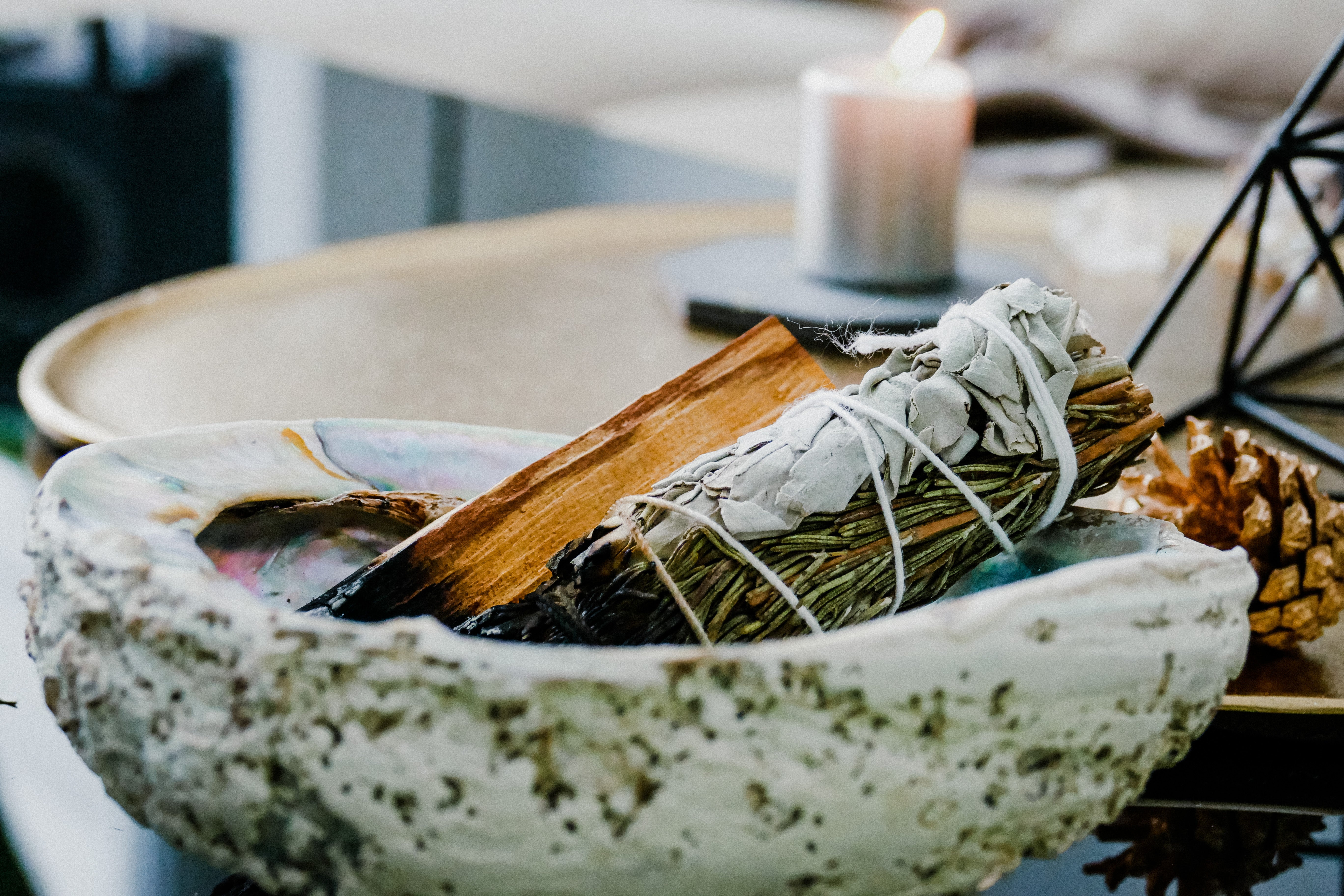I'll never forget the moment I first encountered Palo Santo. After an exhausting workday, I was unwinding by scrolling through Instagram stories. As usual, I was eagerly awaiting posts from a local artist in Spain, whose content was always inspiring and soothing.
A few hours before I drifted onto Instagram, she had posted a short video of her summer evening, spent outside her house to the gentle chirping of cicadas. On a rustic table lay her journal filled with thoughts and a clay plate with something smoldering.
The magic of this moment captivated me so deeply that I decided to message her and ask about this ritual, this smoking stick.
"It's Palo Santo," she replied. "I use it for calming and inspiring creativity."
Little did I know what journey this discovery would take me on the very next day...

The Ancient Power and Use of Palo Santo
Palo Santo. This name refers to the wood of the Bursera graveolens tree, native to South America.
Today, we use this special tree's wood for meditation, relaxation rituals, and attracting positive energy. When a Palo Santo stick is lit and then extinguished, its smoldering releases a distinct and magical fragrance that's difficult to describe. Many say it smells like gentle lemon mixed with baked apple. Others are reminded of burnt, caramelized sugar. But universally, it's rare to find someone who doesn't appreciate Palo Santo's aroma.
Although Palo Santo has only become extremely popular in recent years, the story of this natural incense began during the time of the Incas. Even then, local inhabitants recognized Palo Santo's miraculous power — using it both in spiritual ceremonies and as medicine.
During the Incan period, they also extracted aromatic oil from Palo Santo, using it both for relaxation (applied to the back of the neck or along the spine) and for energetic cleansing of those it was applied to.
This holy wood, as it's known worldwide, is still used by shamans in Peru today. They light the wood stick, carry its smoke around people who come for healing, and use it to cleanse the patient's energetic space, removing all misfortune, negative thought patterns, and malevolent spirits.

In South America, Palo Santo is also used as a tea or water infusion, especially in Ayahuasca rituals. Shamans soak Palo Santo wood in water, offering this infusion as a drink to all ritual participants, as it's necessary to cleanse one's body and spirit of negative energy before the ritual.
The incense quickly became popular in Ecuador as well. There, the practice of burning Palo Santo continues today, as they believe its smoke removes negative energy or "mala energía".
One of the Ecuadorian sayings even speaks of this extraordinary power of Palo Santo:
"Palo santo para limpiar tu casa de la mala energia, palo santo para la buena suerte."
or translated:
"Palo santo to cleanse your home of negative energy, Palo Santo for good fortune."
How is Palo Santo Created?
Bursera graveolens is a wild tree native to Peru and Venezuela. It grows in dry, tropical regions across Mexico, Peru, Guatemala, Ecuador, and many other areas.
However, the journey of Palo Santo from tree to the stick we can burn at home isn't simple.
For the wood to develop its characteristic aroma, the tree must grow and die naturally, which can take 50 to 70 years. If the tree is cut down, it won't develop these signature scents with the power we associate with this wood.
Even after the tree dies naturally and falls, we can't immediately collect, cut, and distribute it. The tree must lie on the ground for at least five to eight years. This is how long it takes for the essential oils within the tree to properly mature, and without this aging process, the wood cannot become the quality incense we know today.

The Issue of Harvesting Palo Santo
Palo Santo or the Bursera graveolens tree is not an endangered species. Since 2010, it has been listed as a "stable" species, but this doesn't mean we can treat this tree irresponsibly.
The demand for Palo Santo is growing, which has led to two problems:
- Some people still illegally cut down trees and sell them on the market,
- Synthetic versions of Palo Santo wood have appeared on the market, filling corporate pockets while leaving users disappointed.
Due to these issues, it's important that as end users, we find trustworthy vendors who sell authentic wood that is sustainably harvested and collected. Only by purchasing such wood will we receive quality incense while preventing any support of suspicious sellers who treat nature irresponsibly.
How to Identify Authentic Palo Santo Wood
Due to the enormous interest in Palo Santo, many traders have decided to sell synthetic versions of Palo Santo sticks or deceive customers by taking shortcuts.
One such shortcut is soaking ordinary wood in various chemicals that create a similar scent to authentic Palo Santo wood. These versions are much less aromatic and also more dangerous for health, as burning the wood releases harmful artificial chemicals into the air.
How can we distinguish synthetic or artificial Palo Santo from the real thing?
Real Palo Santo wood has a beautiful, pleasant, and intense scent that's difficult to describe. Meanwhile, artificial or fake Palo Santo wood has a noticeably less intense scent that isn't as pleasant and resembles the smell of burnt wood.
Real Palo Santo wood will emit white smoke after the flame on the stick goes out. If you're burning a counterfeit stick, the smoke will remain black even after the flame is extinguished.

Healing Properties of Palo Santo
Now that you know what to watch out for when buying Palo Santo wood, it's time to discuss its healing properties.
The characteristic scent of Palo Santo comes from a special compound called Limonene, which is abundant in this tree's essential oil. Limonene is known for its numerous healing effects on our body and spirit. This essential oil is antibacterial, anti-inflammatory, and antiseptic. These properties are why it remains extremely popular among healers worldwide.
Limonene is also incredibly healing in fighting stress, which keeps Palo Santo at the heart of natural relaxation ingredients. People regularly use it during meditation, yoga, or in daily relaxation practices.

Besides all its other properties, Palo Santo is also known for repelling mosquitoes and other insects, which is why many people use it in summer when we start spending our evenings outdoors. Not only will it bring good energy to our gathering, but it will also effectively keep mosquitoes away.
The long history of Palo Santo wood use also testifies to other metaphysical properties of this beautiful gift from nature. With regular use, the wood:
- Enhances our creativity,
- Attracts positive energy,
- Removes negative energy from our surroundings,
- Helps with concentration,
- Creates a stronger connection with our true self.
The Magic of Palo Santo
Not long after I first encountered Palo Santo through that Spanish artist, I ordered my own stick.
I'll never forget the feeling of anticipation while waiting for my package. Along with it came a slight sense of skepticism. Is Palo Santo really as wonderful as others say?
When the day finally came to receive my package, I closed myself in my office, lit a candle, and slowly lit the Palo Santo over it. An intoxicating scent began to spread. I couldn't believe nature could create something so beautiful, something so incredible.
From that moment on, my moments of relaxation were never the same. Since then, Palo Santo has always accompanied me, and that will never change.
It's time for you to experience the magic of this wood too.


![[POSLUŠAJ] Feel Good Vibes](http://www.yoursoultime.si/cdn/shop/articles/Copy_of_VEGAS_IS_WAITING_....png?v=1615219709&width=1200)
